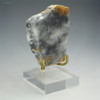First Snowball Earth Huronian Glaciation Rock — 2.4 Ga
Brand : Jensan Scientifics LLC
- SKU:
- JPT-67685
- Condition:
- New
- Availability:
- Usually ships in 24 hours.
- Weight:
- 1.00 LBS
- Minimum Purchase:
- 1 unit
- Maximum Purchase:
- 1 unit
- Shipping:
- Calculated at Checkout
First Snowball Earth: Huronian Glaciation Specimen
Snowball Earth describes periods when our planet was almost entirely covered in ice. The oldest of these global glaciations, the Huronian glaciation, occurred about 2.4 to 2.1 billion years ago. It was triggered by the Great Oxygenation Event, when atmospheric oxygen rose and greenhouse gases declined, plunging Earth into its first super ice age.
About this Snowball Earth Huronian Ice Age Specimen
This specimen was recovered from the Espanola Formation of Ontario, Canada, part of the Huronian Supergroup. It represents one of the earliest and most extreme climate shifts in Earth's history. The rocks preserved evidence of ancient glacial activity, including diamictites that formed under thick ice sheets. These deposits remain among the oldest physical records of planetary glaciation.
Comparison of Major Snowball Earth Glaciations
Earth has experienced three major Snowball Earth events, each leaving behind unique geological evidence. The table below compares their timeframes, locations, and defining features:
| Glaciation | Timeframe (Ma) | Geological Era | Notable Locations | Key Features |
|---|---|---|---|---|
| Huronian | ~2400–2100 | Paleoproterozoic | Ontario (Canada), Lake Huron region | Linked to the Great Oxygenation; the first global glaciation |
| Sturtian | ~720–660 | Cryogenian | Australia, Namibia, North America | Extreme cooling; possible coldest Earth climate |
| Marinoan | ~650–635 | Cryogenian | South China, Australia, Namibia, North America | Severe glaciation, followed by the Ediacaran life explosion |
Geological Significance
The Huronian glaciation is recognized as the first Snowball Earth. Ice extended to tropical latitudes and may have covered the entire planet. These conditions reshaped Earth's surface and influenced the rise of early life. Studying these rocks has provided rare insight into the interplay of oxygen, carbon dioxide, and climate change on a global scale.
Why Collectors Value This Specimen
Specimens from the Huronian glaciation are scarce and highly sought after. They captured one of Earth's most extreme environmental transitions and remain central to the Snowball Earth hypothesis. This piece is not only a scientific collectible but also a tangible reminder of planetary history and climate extremes billions of years old.
Specimen Details
- Size: 62mm L × 56mm W × 18mm D
- Weight: 79 grams
- Location: Espanola Formation, Ontario, Canada
- Geological Age: Paleoproterozoic (2.4–2.1 billion years)
- Condition: Professionally and legally collected. Front face diamond lap polished smooth.
What's Included
- Certificate of Authenticity
- Specimen tag and display stand
- Information on Snowball Earth and glacial cycles
Acrylic cube and base not included.
Geology Rock Collector's Opportunity
If you have been searching for a rare and scientifically important specimen, this is it. No event better illustrates the extremes of climate change than Snowball Earth. This specimen was professionally collected, making it a scarce and fascinating addition to any collection. Secure your piece of deep time today — a true mini museum collectible from Sciencemall-USA.








